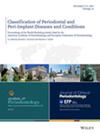Effect of smoking over one pack daily on implant healing and health: A cohort study.
IF 3.8
2区 医学
Q1 DENTISTRY, ORAL SURGERY & MEDICINE
引用次数: 0
Abstract
BACKGROUND This prospective cohort trial examines the effects of heavy smoking on peri-implant marginal bone loss (MBL) and implant survival rates over 15 months. METHODS Thirty subjects, categorized as either smokers (more than 20 cigarettes daily for over 5 years) or non-smokers, were initially recruited with pocket depths ≤ 5 mm and at least one missing tooth. Urine cotinine assay was used to confirm smoking status. Implants were placed and restored after 4 months. Clinical, radiographic and stability variables were assessed at placement, 15, 24, and 67 weeks. Measurements included marginal bone height, peri-implant pocket depth, implant stability, bleeding on probing, and plaque index. Statistical analyses included Mann-Whitney tests for continuous variables, Fisher exact tests for categorical variables, and generalized estimating equations for longitudinal changes. RESULTS Thirteen implants were installed in the smoker group (11 subjects) and 18 in the non-smoker group (18 subjects). Survival rates were lower in smokers (84.6%) compared with non-smokers (94.4%). Smokers experienced significantly greater marginal bone loss 12 months after final reconstruction (1.5 ± 0.3 mm versus 0.7 ± 0.6 mm; p = 0.008). Pocket depth was slightly greater in smokers but this did not reach statistical significance. CONCLUSIONS Heavy smoking significantly increases marginal bone loss and decreases implant survival. Further research is needed to corroborate these findings and develop intervention programs. PLAIN LANGUAGE SUMMARY Heavy smoking is a well-known risk factor for poor dental health, yet its effects on dental implants are less frequently examined. This study investigated how heavy smoking (more than 20 cigarettes daily for at least 5 years) impacts the success of dental implants. We monitored 29 patients, including both heavy smokers and non-smokers, over 15 months after implant placement and restoration. We evaluated bone loss, implant stability, and success rates. Our results showed that heavy smokers experienced significantly more bone loss-twice as much as non-smokers-along with slightly reduced implant stability and survival. These adverse outcomes likely relate to smoking's negative effects on bone healing and immune function. Our findings underscore the importance of addressing smoking before implant procedures and suggest that quitting smoking could greatly improve long-term outcomes. Further research is needed to develop strategies for mitigating the risks of smoking in implant dentistry.每天吸烟超过一包对种植体愈合和健康的影响:一项队列研究。
本前瞻性队列试验研究了重度吸烟对种植体周围边缘骨丢失(MBL)和种植体15个月生存率的影响。方法30例受试者为吸烟者(每天吸烟20支以上,5年以上)或非吸烟者,受试者口袋深度≤5mm,至少缺牙1颗。尿可替宁试验用于确认吸烟状况。植入物放置4个月后恢复。在放置、15、24和67周时评估临床、影像学和稳定性变量。测量包括边缘骨高度、种植体周围口袋深度、种植体稳定性、探针出血和菌斑指数。统计分析包括连续变量的Mann-Whitney检验,分类变量的Fisher精确检验和纵向变化的广义估计方程。结果吸烟组(11例)种植体13枚,非吸烟组(18例)种植体18枚。吸烟者的生存率(84.6%)低于不吸烟者(94.4%)。吸烟者在最终重建后12个月的边缘骨损失明显更大(1.5±0.3 mm vs 0.7±0.6 mm);P = 0.008)。吸烟者的口袋深度略大,但没有达到统计学意义。结论重度吸烟可显著增加种植体边缘骨丢失,降低种植体存活率。需要进一步的研究来证实这些发现并制定干预方案。众所周知,大量吸烟是牙齿健康状况不佳的一个危险因素,但它对种植牙的影响却很少被研究。这项研究调查了重度吸烟(每天吸烟超过20支,持续至少5年)对种植牙成功的影响。我们监测了29例患者,包括重度吸烟者和非吸烟者,在种植体植入和修复后超过15个月。我们评估了骨丢失、种植体稳定性和成功率。我们的研究结果表明,重度吸烟者的骨质流失明显更多,是不吸烟者的两倍,同时种植体的稳定性和存活率也略有下降。这些不良后果可能与吸烟对骨骼愈合和免疫功能的负面影响有关。我们的研究结果强调了在植入手术前解决吸烟问题的重要性,并表明戒烟可以极大地改善长期结果。需要进一步的研究来制定策略,以减轻吸烟在种植牙科中的风险。
本文章由计算机程序翻译,如有差异,请以英文原文为准。
求助全文
约1分钟内获得全文
求助全文
来源期刊

Journal of periodontology
医学-牙科与口腔外科
CiteScore
9.10
自引率
7.00%
发文量
290
审稿时长
3-8 weeks
期刊介绍:
The Journal of Periodontology publishes articles relevant to the science and practice of periodontics and related areas.
 求助内容:
求助内容: 应助结果提醒方式:
应助结果提醒方式:


